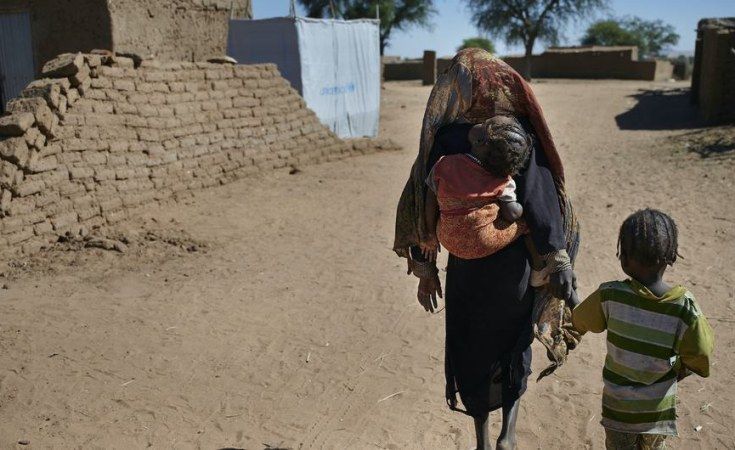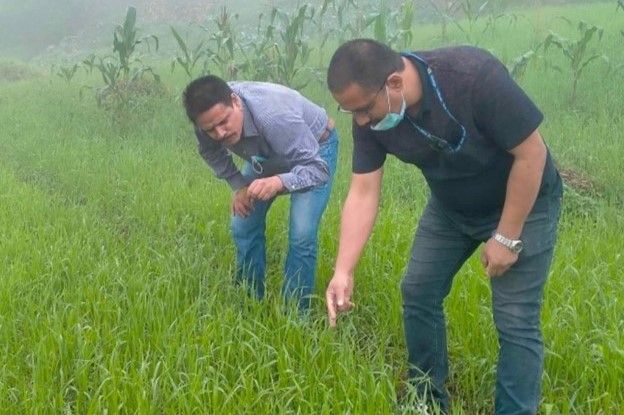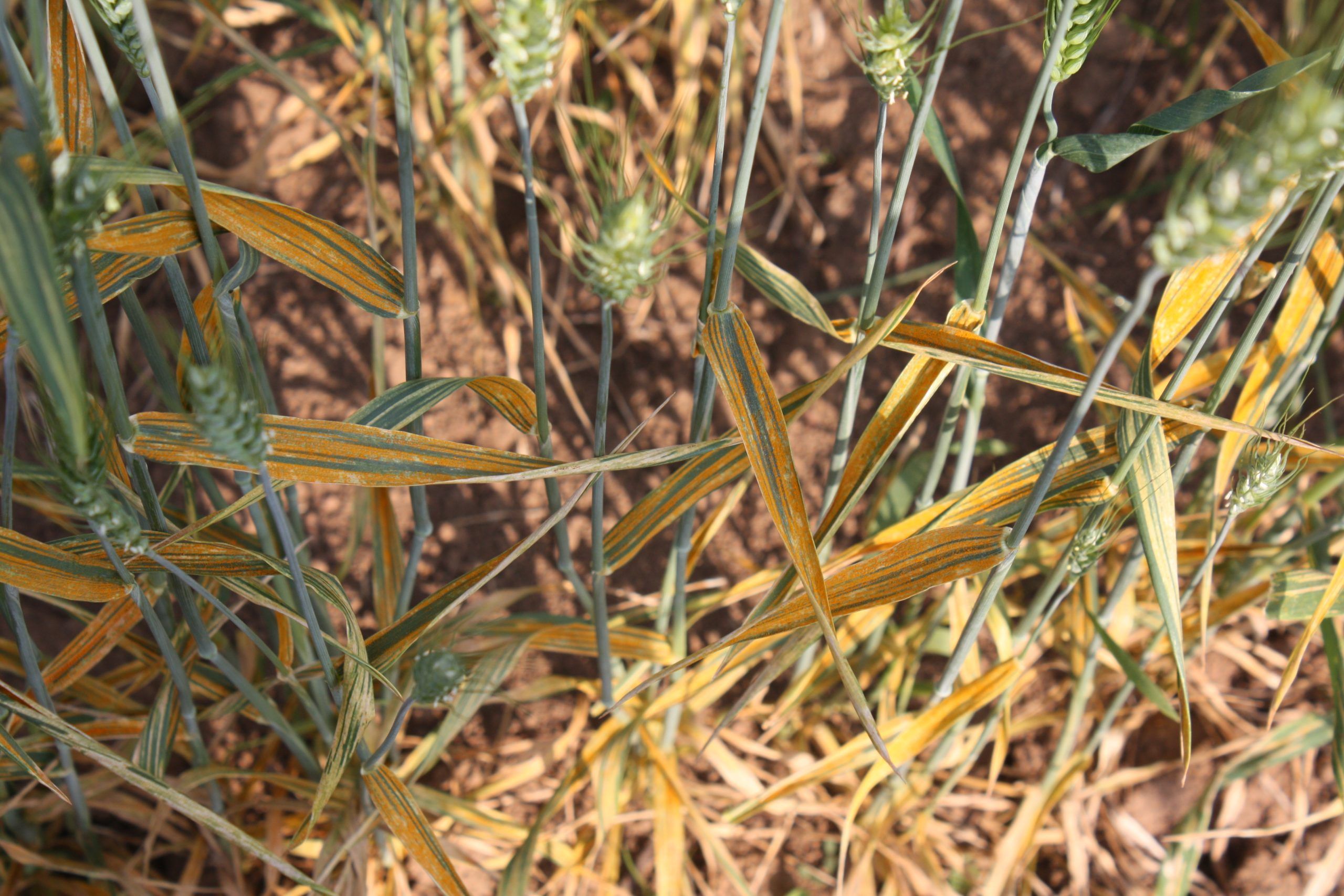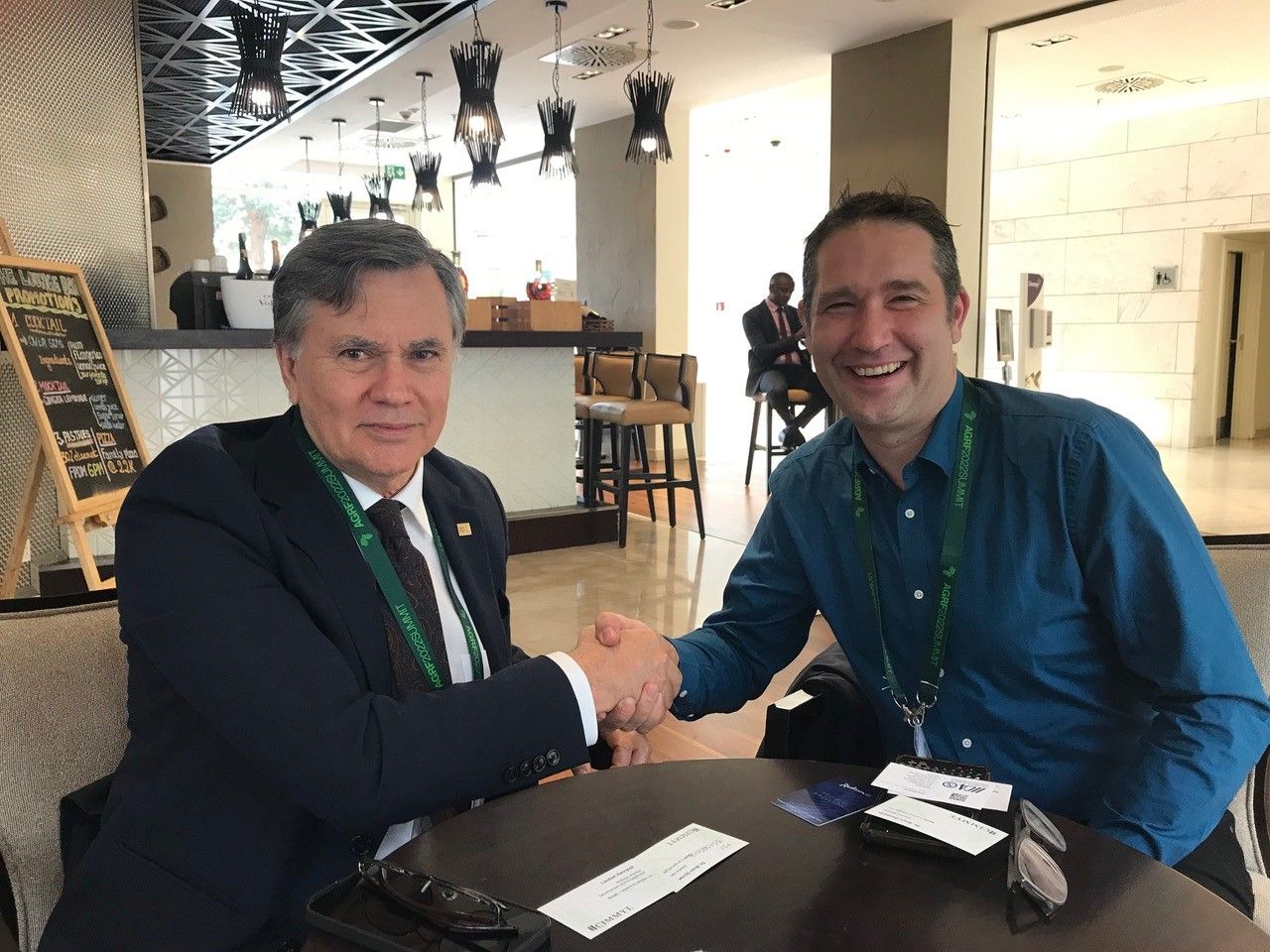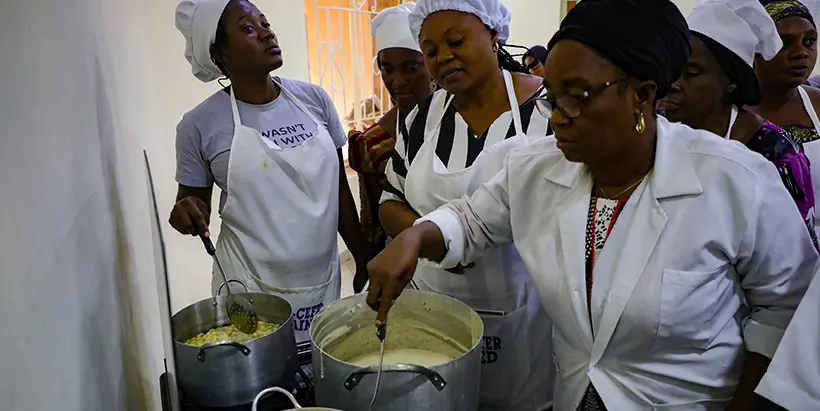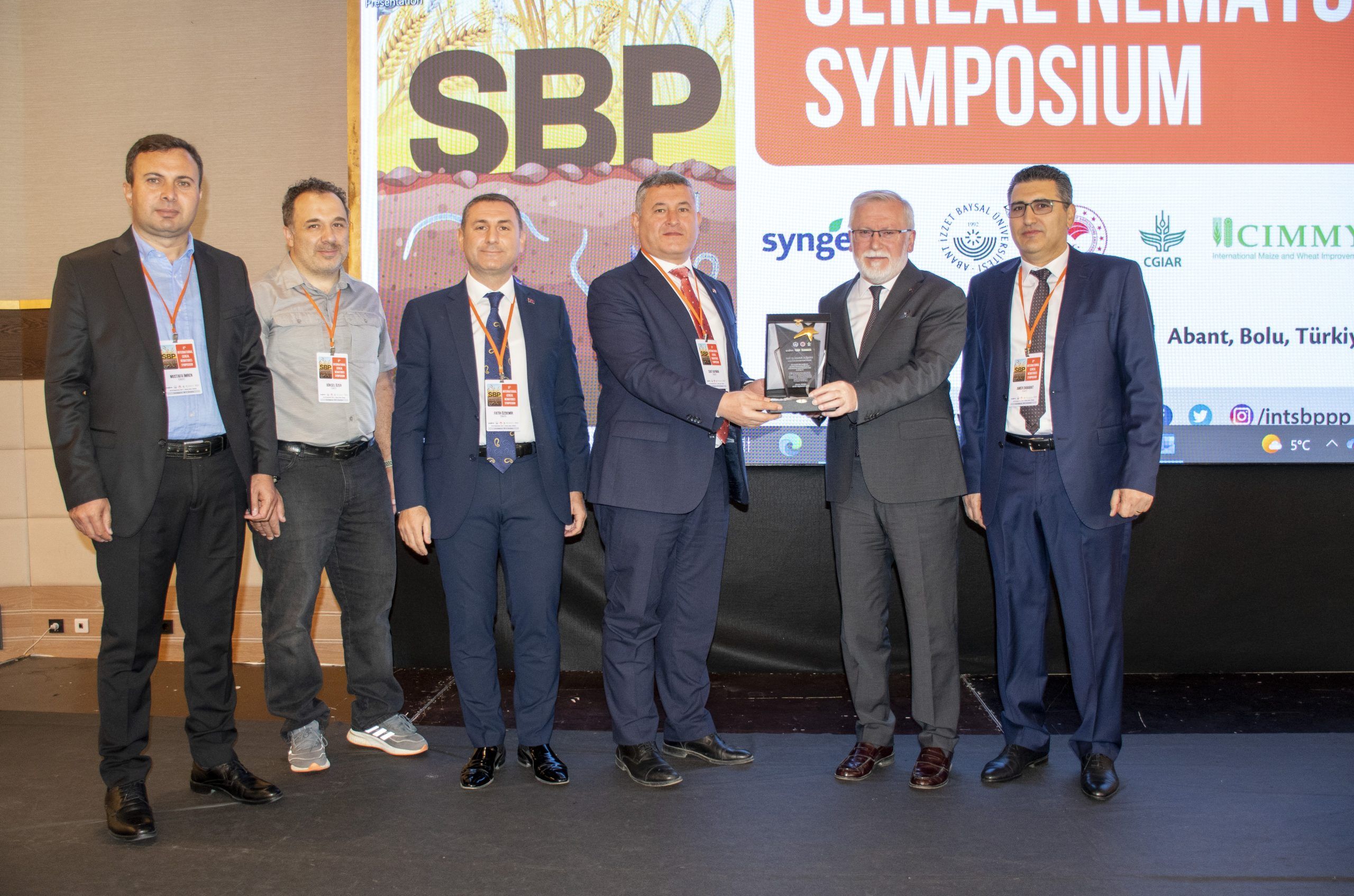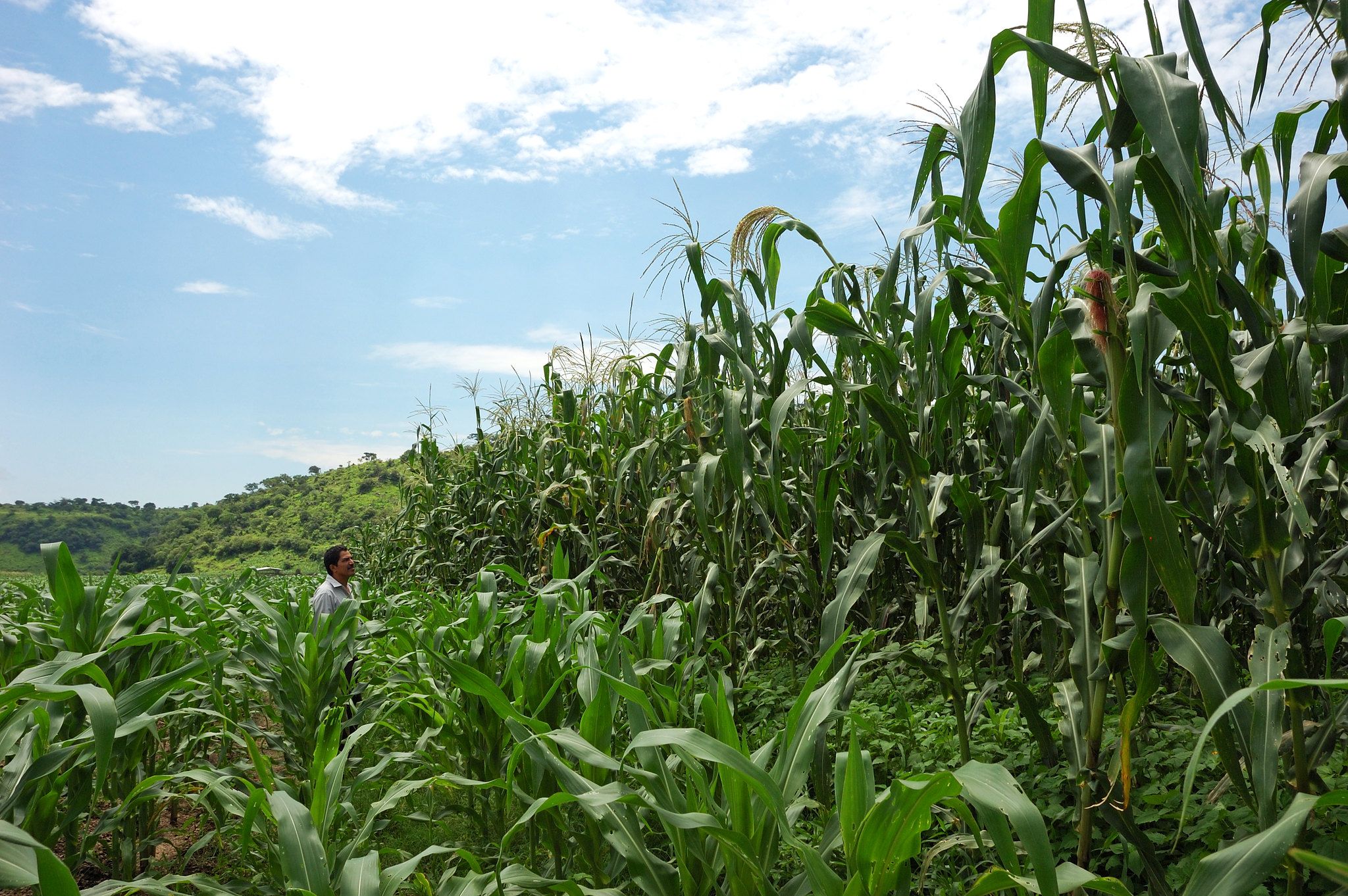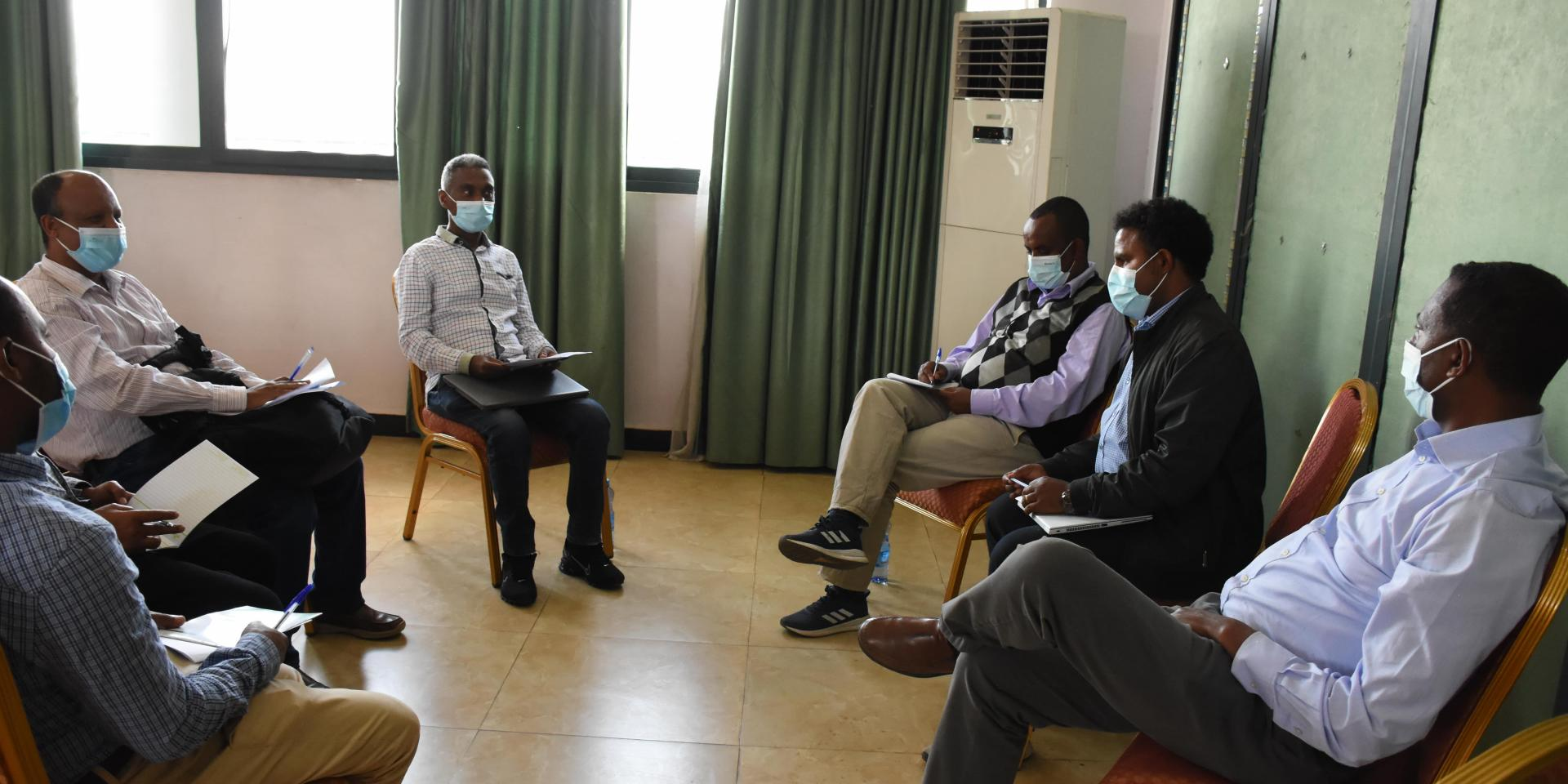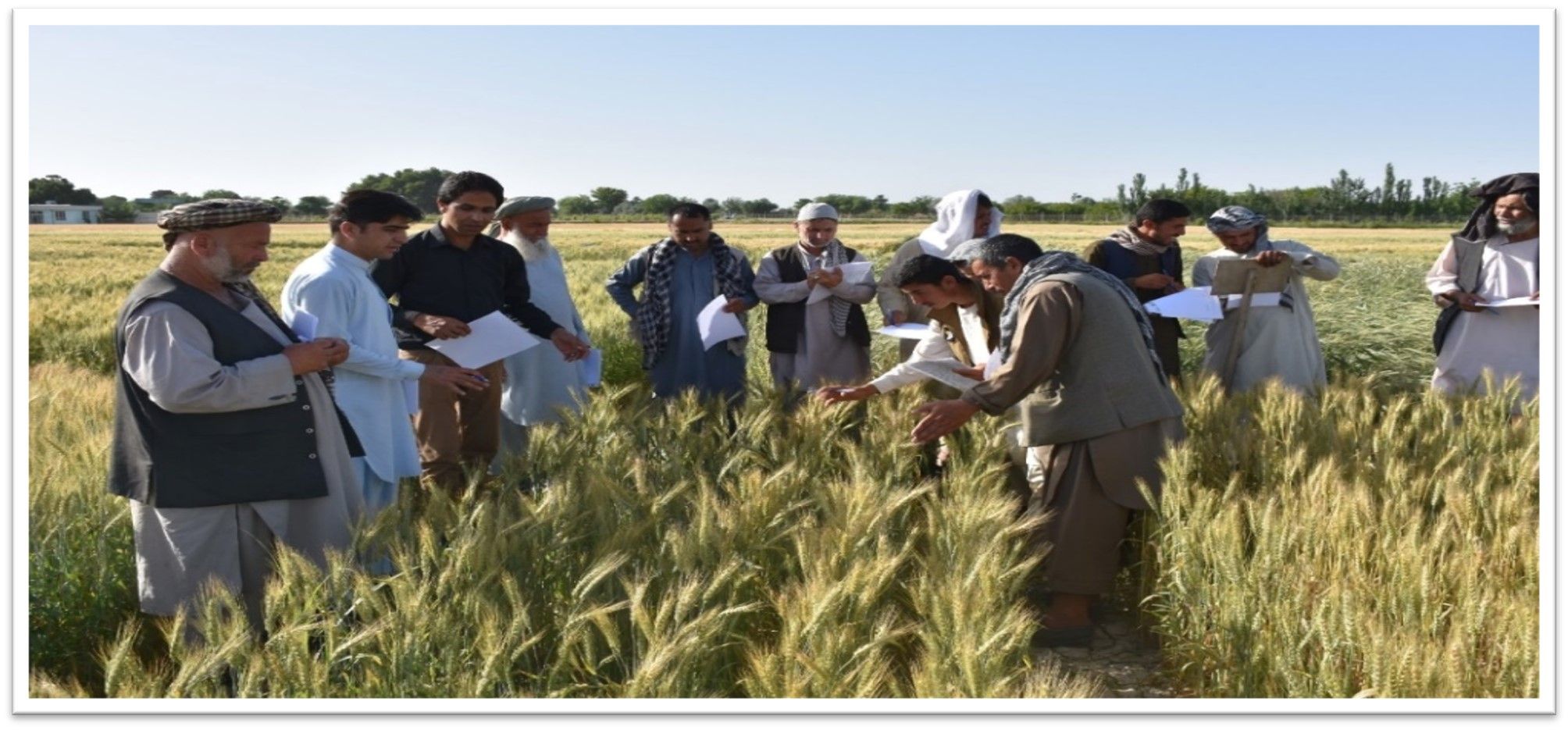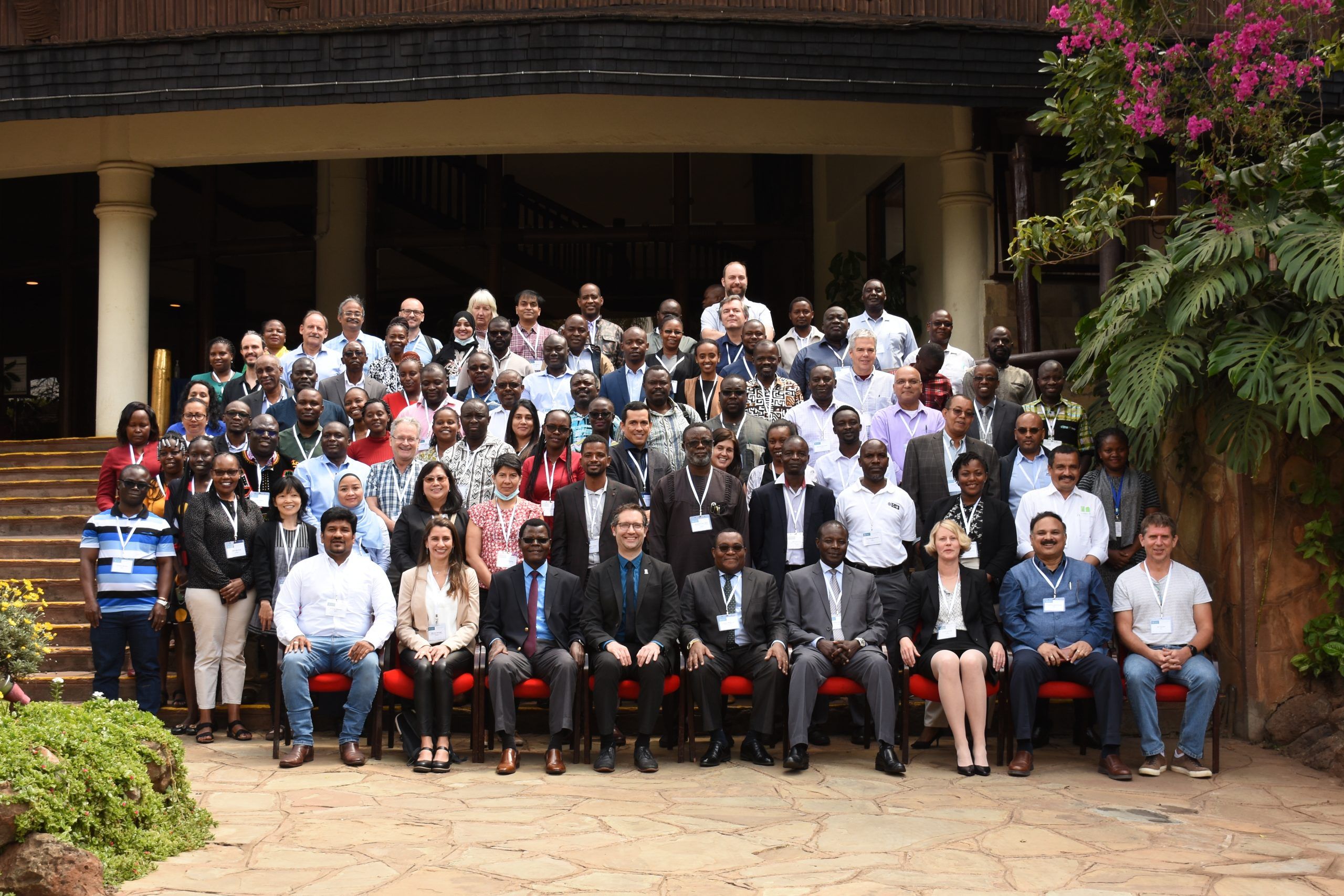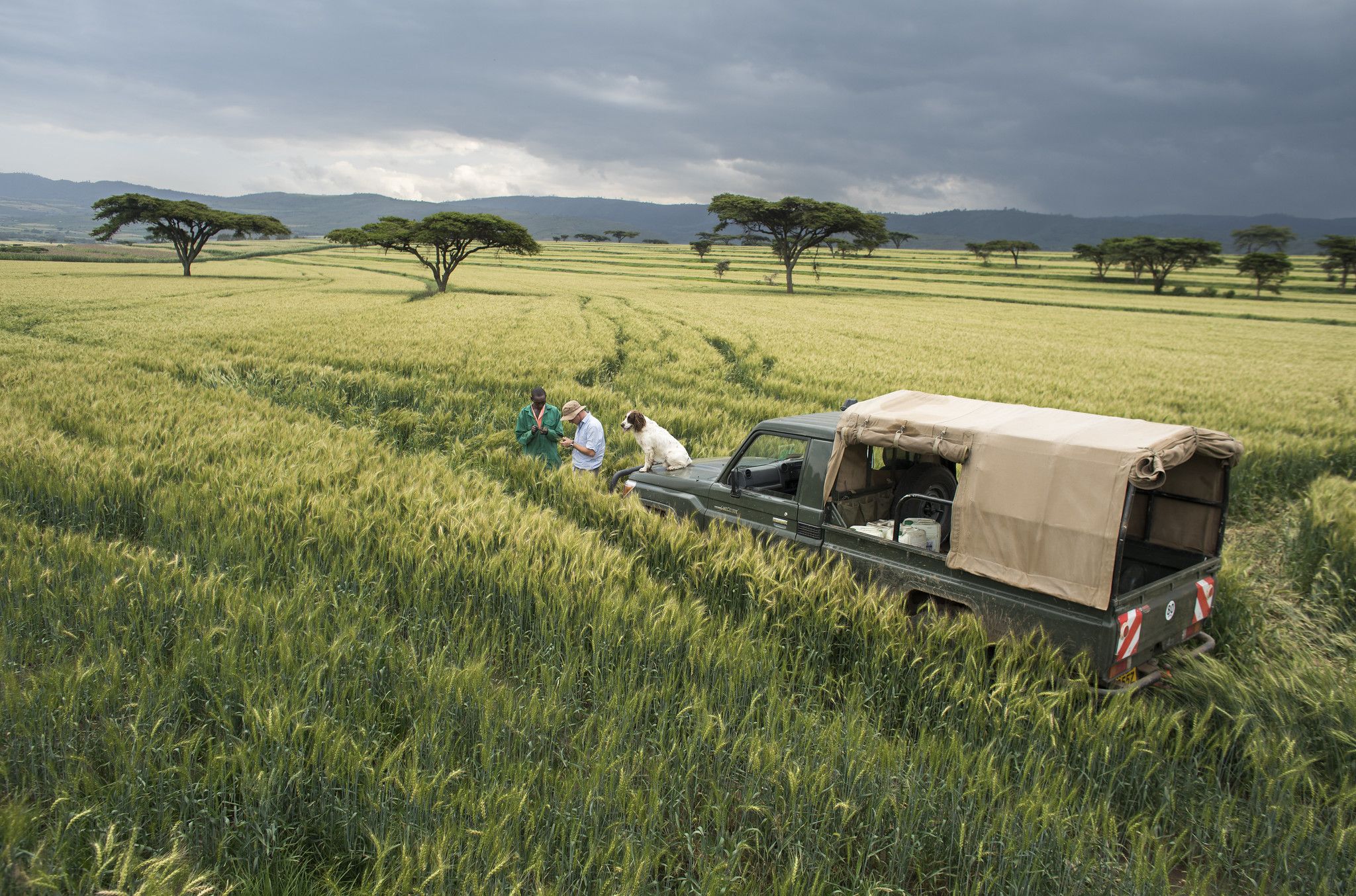funder_partner: International Center for Agricultural Research in the Dry Areas (ICARDA)
Wheat breeding strategies for increased climate resilience
Wheat breeding strategies for increased climate resilience
With the challenges of climate change already affecting plant breeding, especially warmer days and warmer nights, the time to future proof the world’s food supply is now. In order to make the best-informed changes, scientists at CIMMYT ran simulations mimicking five scenarios that might play out over the next 70+ years.
The researchers used 3,652 breeding line records from six global nurseries administered by the International Wheat Improvement Network, which is coordinated by CIMMYT, and involves hundreds of partners and testing sites worldwide. Researchers ran the data through five different climate change scenarios, ranging from stable to severe.
Along with colleagues from Henan Agricultural University, Zhengzhou, China, ICARDA, and the Chinese Academy of Agricultural Sciences, CIMMYT scientists published their research in Nature Climate Change.
The results showed that less than one-third of wheat varieties adapted well to the warming the planet has already seen in the last 10 years. As temperatures increased in the simulation, researchers found a clear connection between rising temperatures and lower stability for a variety. As the global wheat-growing area becomes warmer and experiences more frequent heatwaves, breeding programs have to look beyond just yield optimization.
“Stability is key for breeding programs and farmers,” said co-lead author Matthew Reynolds, CIMMYT distinguished scientist and head of wheat physiology. “Knowing that a specific variety works well in a specific environment and produces an expected amount of yield allows farmers better plan their crop futures.”
“We performed the analysis from different perspectives, so that climate effects and appropriate adjustment suggestions for current breeding models can be considered from climate change, gene selection and/or gene–environment interaction perspectives,” said co-lead author Wei Xiong, CIMMYT Senior Scientist and Agricultural System Modeler.
The paradox of breeding elite lines
Local and regional breeding programs, as well as targeted breeding by CIMMYT, contribute to gene pools that overlap for many key agronomic traits, which limit genetic diversity.
“It is an unintended consequence,” said Reynolds. “As conventional breeding focuses on crossing the best and elite material, such focus can actually reduce genetic diversity.”
This ‘paradox’ shows the need to increase genetic variability and environmental diversification in breeding programs that are developing higher-yielding climate-resilient cultivars. Breeding programs also need to target traits associated with improved adaptation to increased temperatures and tolerance to heatwaves, which requires multidisciplinary integration.
Looking to the past for answers
Over the past 10,000 years, the climate has been unusually stable, meaning modern, domesticated bread wheat has not been exposed to wide swings in temperature that are forecast for the next 100 years. Wild wheat relatives, like Triticeae, have had millions of years of experience in weathering changing climates.
CIMMYT has a pre-breeding program that examines wild wheat races and more exotic sources for climate resilience traits. When such traits are identified genetically, new breeding techniques such as gene editing can be employed and breeding models refined.
To activate these new techniques, several barriers need to be overcome, including more sharing of germplasm between countries and breeding teams, the use of faster breeding cycles where appropriate and improved understanding of genes that improve heat tolerance without a yield penalty.
With reduced climate resilience and slow cultivar development, the need to increase genetic variability for climate adaptation is urgent, particularly in developing countries, where warming rate is unprecedented, and breeding cycles tend to be longer than in developed countries.
“Faced with more climate variability, breeders need to revisit their breeding strategies to integrate genetic diversity that confers climate resilience without penalties to productivity,” said Reynolds.
Sudan: Catastrophic hunger amid conflict creates a crisis of instability across northeast Africa
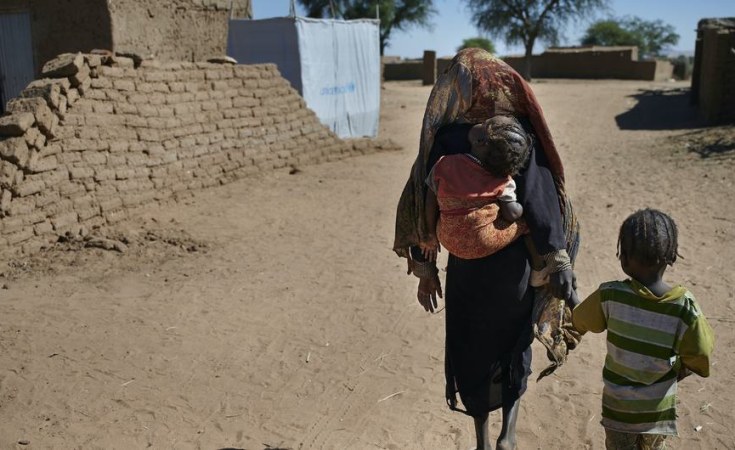
Sudan, the third largest country in Africa, is on the verge of a food crisis of epic proportions. Since the outbreak of civil war in April 2023, the country has descended rapidly into political upheaval, severe economic contraction, extreme social unrest, and rampant violence.
In addition to the estimated 13,000-15,000 people killed and 33,000 injured, some 6.3 million people have been internally displaced and more than 1.7 million have crossed into neighboring countries as refugees. Many are women and children.
The United Nations considers this the largest child displacement crisis in the world. About 25 million people urgently require food assistance, including more than 14 million children. Acute food insecurity is affecting 18 million people, or 37 percent of the population, with another 10 percent in emergency conditions.
News stories are dominated by reports of violent clashes and political maneuverings. So far, coverage of food insecurity has been scant. As is often the case, this topic seems to only get traction when there is outright famine.
This gets the story backwards. Food insecurity is at the root of many conflicts. Moreover, peace remains elusive without well-functioning agricultural systems, and it is unreasonable to expect viable agricultural production without peace.
Anticipating significantly reduced harvests in Sudan, UN agencies are projecting 50-100 percent price hikes for staple grains over the coming months. Following a doubling in food price over the previous two years, Sudan’s need for food aid will grow exponentially, while logistical barriers to humanitarian operations are getting harder to overcome.
The UN Office for the Coordination of Humanitarian Affairs (UNOCHA) has called for peace-building, unimpeded passage of humanitarian relief, and agricultural livelihood support. And the World Food Program warns that without substantial intervention, catastrophic hunger is likely to prevail in conflict hotspots by next year’s lean season.
Most of Sudan’s 45 million people rely on farming for their livelihoods. Yet only 3.5 percent of requested donor funding for the 2024 Sudan Humanitarian Needs and Response Plan has been provided.
With more frequent and severe droughts and floods degrading agricultural productivity, the income and food security of farming families has become more precarious over recent decades. Concurrent erosion in governance and social protection systems accelerates a vicious cycle of vulnerability, social tension, and maladaptive coping strategies.
In already fragile agricultural areas, displacement of millions of people is severely impacting the agriculture sector, disrupting input supply and agricultural services and limiting labor availability. Producers, input suppliers, processors, and traders all struggle to operate with communication systems interrupted by conflict preventing normal commercial transactions and movement of produce.
Just five years ago, Sudan’s agri-food sector contributed 32 percent to total GDP. In 2023, the country has seen a 20 percent drop in agricultural GDP and employment. If no preventive action is taken this year, an estimated 1.8 million more people will fall into poverty amid the ongoing conflict.
With significant untapped agroecological potential, Sudan’s economic and political stability depends on a transition to productive and climate-resilient agriculture. But this demands investment in farm management capacity, improved use of inputs and irrigation, and increased access to markets and finance, as well as viable governance of rural infrastructure and natural resources. The situation in Sudan is especially challenging given the weakened state of agricultural supply chains and the extension system, the two backbones of the agricultural sector.
To boost food supplies and prevent depletion of productive assets, international organizations are working to provide Sudanese farmers with high-quality seeds, agrochemicals, livestock vaccines, and fuel on an emergency basis. The situation requires the sustained presence of support agencies.
However, the blanket economic embargo placed on Sudan has made it difficult, if not impossible, for local development agencies to access project funds vital for saving lives and sustaining livelihoods.
Extreme uncertainty in conflict zones hampers interventions designed to reduce dependency on food aid and increase the resilience of local farming systems. By sharing knowledge resources, foresight capabilities, and decision frameworks, partner organizations can better anticipate and reduce human suffering and disaster relief costs.
Sudan is facing a complex emergency, which may lead to state failure, mass migration, resource conflicts, and starvation, triggering waves that would be felt across all of northeastern Africa. Sudan is too big to fail.
Climate-resilient agricultural livelihoods are the engine of food security and social stability. This cannot be achieved in one or two years, so the global community must have long-term aspirations to support the transformation of agrifood systems in Sudan.
We need to adapt our strategies to build resilience before, during, and after periods of conflict. By reducing poverty, in-country inequality, and other societal drivers, increased agricultural resilience can help mitigate and moderate conflict.
The victims of the current conflict have no political capital and may have little idea why the warring sides took up arms. To relieve the extreme suffering in Sudan, it is the responsibility of the international community to marshal the political will to achieve a negotiated truce and a sustained ceasefire.
Successful surveillance results in early first detection of Ug99 in South Asia
Successful global wheat disease surveillance and monitoring has resulted in early detection of wheat stem rust Ug99 in Nepal. A combination of vigilant field surveys and sampling by Nepal’s National Plant Pathology Research Centre (NPPRC) and National Wheat Research Program (NWRP), supported by rigorous and accurate disease diagnostics at the Global Rust Reference Center (GRRC), Denmark, resulted in confirmed detection of the Ug99 strain named TTKTT. The long running and sustained surveillance efforts undertaken by NPPRC and NWRP, including off-season surveys, proved vital in the detection of Ug99 in Nepal. Confirmed results were obtained from two field samples collected in early November 2023 from off-season summer wheat crops in Dolakha district, Nepal. Repeated experiments and high quality pathotyping and genotyping at GRRC confirmed the results.
“The combination of molecular genotyping of incoming samples, without prior recovery in our laboratory and independent diagnostic assays of recovered stem rust isolates, confirmed the presence of Ug99 and a highly virulent race variant termed TTKTT,” says professor Mogens Hovmøller, leader of the GRRC at Aarhus University in Denmark.
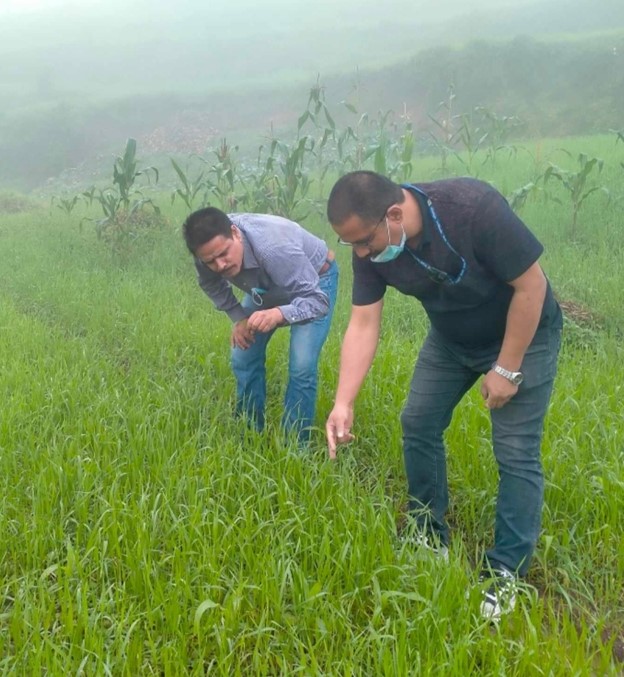
Ug99 was first detected in East Africa in 1998/99, and its unique virulence sparked fears that a large proportion of wheat cultivars globally would be at risk from this potentially devastating disease. The international wheat community came together through the Borlaug Global Rust Initiative (BGRI) to address the threats posed by Ug99. The BGRI partners have successfully monitored the evolution and spread of Ug99 and bred hundreds of resistant wheat varieties that are now being grown at scale in priority wheat growing regions. Migration of Ug99 from Africa to other regions, including South Asia, was always seen as likely due to the transboundary nature of the disease and long-distance dispersal of rust spores by wind.
Detection of a Ug99 race in Nepal is not therefore a surprise, but it highlights the effectiveness of the wheat rust surveillance and monitoring systems that have been developed. The disease was present at extremely low levels in the fields in Nepal, and early detection is one of the main factors in preventing disease spread. Other factors also contribute to reduced risk. The wheat on which the Ug99 race TTKTT was detected were fodder crops and cut soon after the surveys were completed, which prevented further buildup of disease. In addition, no wheat is grown in the main season in these areas, with farmers shifting to cultivation of potato (a non-host crop for stem rust).
According to Suraj Baidya, senior scientist and chief of NPPRC, “Extensive follow up surveys in the Dolakha detection area by NPPRC in the 2023/24 main season resulted in no wheat being observed and no detection of stem rust.” Similarly, extensive surveys by NPPRC throughout other wheat growing areas of Nepal in the 2023/24 main season have resulted in no reports of stem rust in the country. To date, extensive surveys in other countries in South Asia (Pakistan, Bangladesh, Bhutan) have not detected stem rust in 2023/24.
Although the current risk of stem rust outbreaks is considered to be low, detection of the Ug99 race TTKTT in Nepal is a clear reminder of the threat posed to wheat production in South Asia by the incursion of virulent stem rust races or other plant diseases of concern. “The spread and risk from transboundary diseases like stem rust is increasing,” says Dave Hodson, leader of the Wheat Disease Early Warning Advisory Systems (DEWAS) project at CIMMYT. “Sustained and increased surveillance efforts are needed across the region and expanded to include other important emerging diseases.” Successful deployment of Ug99 resistant cultivars through the BGRI partners, including CIMMYT, ICARDA and NARS, has decreased vulnerability, but it is important to note that the race TTKTT is a recently evolved variant of Ug99 with additional virulence compared to the original strains. As a result, not all cultivars in South Asia may have effective resistance today. Screening of germplasm and major cultivars from South Asia against TTKTT at the Kenya Agriculture and Livestock Research Organization (KALRO)/CIMMYT international stem rust screening nursery in Kenya is extremely important to get an accurate picture of current vulnerability.
The details of the diagnostic confirmation of Ug99 in Nepal are available at the GRRC website (see GRRC lab report)
Work on wheat disease surveillance and monitoring, plus breeding of resistant varieties is being supported by the DEWAS and AGG projects funded by BMGF and FCDO, UK.
Key partners –
National Plant Pathology Research Centre (NPPRC), Nepal. Contact: Suraj Baidya (suraj_baidya222@yahoo.co.in)
National Wheat Research Program (NWRP), Nepal. Contact: Roshan Basnet
Global Rust Reference Center (GRRC), Aarhus University, Denmark. Contact: Mogens Hovmøller (mogens.hovmoller@agro.au.dk)
Cornell University. Contact: Maricelis Acevedo (ma934@cornell.edu)
CIMMYT. Contact: David Hodson (d.hodson@cgiar.org)
Wheat pathogen surveillance system set to expand through new investment
One of the world’s largest crop pathogen surveillance systems is set to expand its analytic and knowledge systems capacity to protect wheat productivity in food vulnerable areas of East Africa and South Asia.
Researchers announced the Wheat Disease Early Warning Advisory System (Wheat DEWAS), funded through a $7.3 million grant from the Bill & Melinda Gates Foundation and the United Kingdom’s Foreign, Commonwealth & Development Office, to enhance crop resilience to wheat diseases.
The project is led by David Hodson, principal scientist at CIMMYT, and Maricelis Acevedo, research professor of global development and plant pathology at Cornell University’s College of Agriculture and Life Sciences. This initiative brings together research expertise from 23 research and academic organizations from sub-Saharan Africa, South Asia, Europe, the United States and Mexico.
Wheat DEWAS aims to be an open and scalable system capable of tracking important pathogen strains. The system builds on existing capabilities developed by the research team to provide near-real-time model-based risk forecasts and resulting in accurate, timely and actionable advice to farmers. As plant pathogens continue to evolve and threaten global food production, the system strengthens the capacity of countries to respond in a proactive manner to transboundary wheat diseases.
The system focuses on the two major fungal pathogens of wheat known as rust and blast diseases. Rust diseases, named for a rust-like appearance on infected plants, are hyper-variable and can significantly reduce crop yields when they attack. The fungus releases trillions of spores that can ride wind currents across national borders and continents and spread devastating epidemics quickly over vast areas.
Wheat blast, caused by the fungus Magnaporte oryzae Tritici, is an increasing threat to wheat production, following detection in both Bangladesh and Zambia. The fungus spreads over short distances and through the planting of infected seeds. Grains of infected plants shrivel within a week of first symptoms, providing little time for farmers to take preventative actions. Most wheat grown in the world has limited resistance to wheat blast.
“New wheat pathogen variants are constantly evolving and are spreading rapidly on a global scale,” said Hodson, principal investigator for Wheat DEWAS. “Complete crop losses in some of the most food vulnerable areas of the world are possible under favorable epidemiological conditions. Vigilance coupled with pathogen-informed breeding strategies are essential to prevent wheat disease epidemics. Improved monitoring, early warning and advisory approaches are an important component for safeguarding food supplies.”
Previous long-term investments in rust pathogen surveillance, modelling, and diagnostics built one of the largest operational global surveillance and monitoring system for any crop disease. The research permitted the development of functioning prototypes of advanced early warning advisory systems (EWAS) in East Africa and South Asia. Wheat DEWAS seeks to improve on that foundation to build a scalable, integrated, and sustainable solution that can provide improved advanced timely warning of vulnerability to emerging and migrating wheat diseases.
“The impact of these diseases is greatest on small-scale producers, negatively affecting livelihoods, income, and food security,” Acevedo said. “Ultimately, with this project we aim to maximize opportunities for smallholder farmers to benefit from hyper-local analytic and knowledge systems to protect wheat productivity.”
The system has already proven successful, contributing to prevention of a potential rust outbreak in Ethiopia in 2021. At that time, the early warning and global monitoring detected a new yellow rust strain with high epidemic potential. Risk mapping and real-time early forecasting identified the risk and allowed a timely and effective response by farmers and officials. That growing season ended up being a production record-breaker for Ethiopian wheat farmers.
While wheat is the major focus of the system, pathogens with similar biology and dispersal modes exist for all major crops. Discoveries made in the wheat system could provide essential infrastructure, methods for data collection and analysis to aid interventions that will be relevant to other crops.
Wheat Disease Early Warning Advisory System (DEWAS)
The Wheat Disease Early Warning Advisory System (Wheat DEWAS) project is bringing new analytic and knowledge systems capacity to one of the world’s largest and most advanced crop pathogen surveillance systems. With Wheat DEWAS, researchers are building an open and scalable system capable of preventing disease outbreaks from novel pathogen strains that threaten wheat productivity in food vulnerable areas of East Africa and South Asia.
The system builds from capabilities developed previously by multi-institutional research teams funded through long-term investments in rust pathogen surveillance, modelling, and diagnostics. Once fully operationalized, the project aims to provide near-real-time, model-based risk forecasts for governments. The result: accurate, timely and actionable advice for farmers to respond proactively to migrating wheat diseases.
The Challenge
Farmers growing wheat face pathogen pressures from a range of sources. Two of the most damaging are the fungal diseases known as rust and blast. Rust is a chronic issue for farmers in all parts of the world. A study in 2015 estimated that the three rust diseases — stem, stripe and leaf — destroyed more than 15 million tons of wheat at a cost of nearly $3 billion worldwide. Wheat blast is an increasing threat to wheat production and has been detected in both Bangladesh and Zambia. Each of these diseases can destroy entire harvests without warning, wiping out critical income and food security for resource-poor farmers in vulnerable areas.
The Response
Weather forecasts and early-warning alerts are modern technologies that people rely on for actionable information in the case of severe weather. Now imagine a system that lets farmers know in advance when dangerous conditions will threaten their crop in the field. Wheat DEWAS aims to do just that through a scalable, integrated, and sustainable global surveillance and monitoring system for wheat.
Wheat DEWAS brings together research expertise from 23 research and academic organizations from sub-Saharan Africa, South Asia, Europe, the United States and Mexico.
Together, the researchers are focused on six interlinked work packages:
| Work package | Lead | Objectives |
| Data Management | Aarhus University; Global Rust Reference Center |
|
| Epidemiological Models | Cambridge University |
|
| Surveillance (host + pathogen) | CIMMYT |
|
| Diagnostics | John Innes Centre |
|
| Information Dissemination and Visualization Tools | PlantVillage; Penn State |
|
| National Partner Capacity Building | Cornell University |
|
Wheat DEWAS partners
Academic organizations: Aarhus University / Global Rust Reference Center; Bangabandhu Sheikh Mujibur Rahman Agricultural University; Cornell University / School of Integrative Plant Science, Plant Pathology & Plant-Microbe Biology Section; Hazara University; Penn State University / PlantVillage; University of Cambridge; University of Minnesota
Research organizations: Bangladesh Wheat and Maize Research Institute (BWMRI); CIMMYT; Department of Agricultural Extension (DAE), Bangladesh; Ethiopian Agricultural Transformation Institute (ATI); Ethiopian Institute of Agricultural Research (EIAR); ICARDA; John Innes Centre (JIC); Kenya Agricultural and Livestock Research Organization (KALRO); National Plant Protection Centre (NPPC), Bhutan; Nepal Agricultural Research Council (NARC); Pakistan Agricultural Research Council (PARC); UK Met Office; Tanzania Agricultural Research Institute (TARI); The Sainsbury Laboratory (TSL) / GetGenome; U.S. Department of Agriculture, Agricultural Research Service; Zambia Agricultural Research Institute (ZARI)
Agriculture for Peace platform launches at Borlaug Dialogue
Events of the past year have underscored the correlation of food supply chains, and weaknesses that need to be addressed. Tackling threats to global food security caused by COVID-19, conflict, and climate change require joint action and long-term commitments, with approaches based on partnerships, collaborative research and information sharing, and involvement from all actors within agrifood systems.
These topics and potential solutions were integral to the 2022 Norman E. Borlaug International Dialogue, hosted between October 18-20, 2022. With a theme of Feeding a Fragile World and overcoming shocks to the global food system, seminars and workshops explored scalable solutions for adaptation and mitigation to limit global warming and meet the UN Sustainable Development Goals (SDGs).
One event which proposed a solution to these challenges was Agriculture for Peace (Ag4Peace): A Call for Action, which marked the official launch of a platform aiming to support national food and agriculture strategies.
The initiative was founded by seven partners: Norman Borlaug Foundation, the International Maize and Wheat Improvement Center (CIMMYT), Cornell University College of Agriculture and Life Sciences, the International Center for Agricultural Research in the Dry Areas (ICARDA), the International Livestock Research Institute (ILRI), the International Rice Research Institute (IRRI) and Texas A&M University.
During the event, two additional collaborators were announced: World Wide Fund for Nature and Inter-American Institute for Cooperation on Agriculture (IICA).
The Ag4Peace concept
Ag4Peace is built on the understanding that without peace there is no food, and without food there is no peace. Conflicts and violence severely disrupt agricultural processes and limit access to food, which in turn forces people to take increasingly perilous actions as they attempt to secure their lives and those of their families. High food prices and hunger cause instability, migration, and civil unrest as people become more desperate.
Using a collaborative approach, partners will design holistic strategies that encompass the multi-faceted nature of agrifood systems and their interconnections with nature, nutrition, and livelihoods. This requires broad-based collaborations, so the Ag4Peace partners welcome other institutions, private sector, and non-governmental organizations that share their aspirations to join them.
Partners are co-constructing the Cross-Sector Collaboration to Advance Resilient Equitable Agrifood Systems (CC-AREAS), the first operational plan for the platform. This is a 10-year proof-of-concept program that applies a holistic, systems approach to achieve resilient agrifood systems and accelerate development of the circular bioeconomy in five low- and middle-income countries (LMICs) that are increasingly exposed to food security risks due to climate change and reliance on imported staple foods.
They will support national efforts to upgrade agrifood systems, adopt regenerative agriculture and climate-smart strategies, expand the circular bioeconomy, and achieve nutrition and food security goals.
In all aspects of the initiative (science, planning, implementation, and evaluation), participation priority will be given to small-scale farmers, women, and socially diverse groups, which will maximize positive outcomes and ensure inclusivity.
Benefits for farmers, communities, value chain participants, consumers, and ecosystems will be demonstrated throughout to encourage adoption and continued use of improved technologies and practices and demonstrate effectiveness.
Partner support for Ag4Peace
After the concept was introduced by Bram Govaerts, Director General of CIMMYT and recipient of the 2014 Norman Borlaug Award for Field Research and Application, a roundtable discussion with a diverse panel of experts began.
Speakers included Manuel Otero, Director General of the Inter-American Institute for Cooperation on Agriculture (IICA), Hon. Sharon E. Burke, Global Fellow of Environmental Change and Security Program at the Wilson Center, Per Pinstrup-Anderson, Professor and World Food Prize Laureate, and Alice Ruhweza, Africa Regional Director of the World Wildlife Fund (WWF).
Moderated by Margaret Bath, Chair of CIMMYT Board of Trustees, the panelists conveyed Ag4Peace’s aims of building productive, sustainable, and resilient agrifood systems, improving livelihoods for small-scale producers and other value chain actors, and deliver nutritious, affordable diets.
“Hunger is part of the picture of conflict,” explained Burke. “These strapped communities are often competing for resources with each other, within their own boundaries, and sometimes food is a weapon in these places, just as destructive as a bomb or a gun. Without food there is no peace, in the near or the long-term.”
Trade-offs versus win-wins
Pinstrup-Anderson ruminated on the importance of win-wins, which are solutions that work for supporting human health and protecting our natural environment without sacrificing results in one area for results in another. “We do not have to give up improving nutrition just to save the climate or save the earth – we can do both,” he said.
The significance of strong partnerships arose multiple times, such as when Otero explained, “It is not a matter of working just with the agriculture ministers but also with other ministers – foreign affairs, social development, environmental – because agriculture is a sector that crosses across all these institutions.”
Ruhweza explored whether threats to food security, such as COVID-19, conflict, and climate change, can also bring opportunities. “The right action on food systems can also accelerate the delivery of all our goals on climate and nature,” she said. “WWF is looking forward to partnering with this initiative.”
Final remarks from Julie Borlaug, President of the Norman Borlaug Foundation, where the platform will be housed, reiterated a call for more partners to join the coalition. “This is a learning lesson as we go. We will iterate over and over until we get it right, so we need all of you to be involved in that,” said Borlaug. “Join us as we move forward but let us know as we’re going sideways.”
CGIAR scientist honored with award
The winner of the annual Norman Borlaug Award for Field Research and Application award was announced at the Borlaug Dialogue, which this year went to Mahalingam Govindaraj, Senior Scientist for Crop Development at HarvestPlus and at the Alliance of Bioversity International and CIAT, a CGIAR research center.
Govindaraj received the award for his leadership in mainstreaming biofortified crops, particularly high-yielding, high-iron, and high-zinc pearl millet varieties. This work has contributed to improved nutrition for thousands of farmers and their communities in India and Africa, and estimates show that, by 2024, more than 9 million people in India will be consuming iron- and zinc-rich pearl, benefiting from improved nutrition.
Cover photo: The historical moment when Manuel Otero, Director General of IICA, joins the Agriculture for Peace initiative with Bram Govaerts, Director General of CIMMYT. (Photo: Liesbet Vannyvel/CIMMYT)
New WIRES initiatives to advance women’s careers in science and research
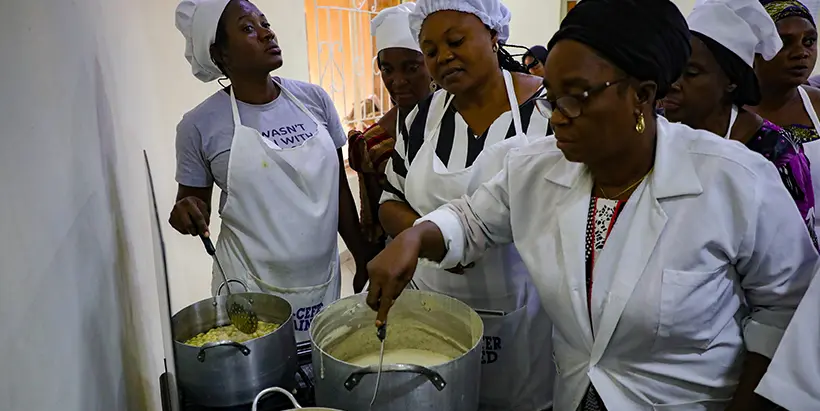
The CGIAR Women in Research and Science (WIRES) employee-led resource group recently had a virtual engagement to discuss the progress and new happenings in the group. The meeting, themed “Connecting and Mentoring, What’s new with WIRES!” was held on October 24.
Giving the opening remarks, The Alliance of Bioversity International and CIAT Knowledge Sharing Specialist Arwen Bailey stated that the group was launched in July 2020 to empower and increase the visibility of women research and science professionals across CGIAR.
Bailey and other co-coordinators, International Maize and Wheat Improvement Center (CIMMYT) Technical Program Manager Aparna Das, IITA HarvestPlus Cassava Breeder Elizabeth Parkes, and International Center for Agricultural Research in the Dry Areas (ICARDA) Communication Consultant Nada Abdelhamid, shared their reasons for volunteering in WIRES. Participants also highlighted their expectations for the meeting.
Explaining the vision and mission of the group, Das stated that WIRES aims to provide tools and knowledge that support professional development. She added that this would create visibility for CGIAR women in science and research so their voices are heard and their contributions recognized. “We are an open community that accommodates both men and women who are willing to support the vision of WIRES,” she said.

Discussing her reason for sponsoring WIRES, CGIAR Executive Managing Director Claudia Sadoff said she admires the efforts and engagement of the team in supporting women despite having other personal life activities. She added that the increase in the percentage of women scientists calls for more effort to train and empower these women. “Thanks for allowing me to be your sponsor,” she said. International Livestock Research Institute (ILRI) Director General Jimmy Smith, also a sponsor, stated that his motivation to join the cause stems from his experience raising daughters.
Highlighting how intending volunteers can support WIRES, Das spoke on mentorship as a promising strategy to advance Gender, Diversity and Inclusion (GDI) in the workplace as it offers access and advocacy for women. Explaining the criteria for engagement, she stated that a mentor must be passionate about advancing GDI, while the mentee must be a middle to senior-level career woman researcher/scientist with an appetite to learn. “Registration for the program will begin in November, and the program will kick off in December. Interested mentors and mentees who meet the criteria can register and be trained,” she said.
Other new WIRES initiatives coming up before the end of 2022 include “Random coffee,” where members can schedule to meet physically or virtually to build a vibrant relationship and network, and “Focus groups” for discussions that will ensure continuous improvement for WIRES.
Closing out the meeting, CGIAR Global Director of People and Culture, Fiona Bourdin-Farrell, summarized ways volunteers can help to advance women in science and research in CGIAR. She mentioned that it starts with joining the WIRES team, being a part of the mentoring program, engaging in the random coffee pilot, and joining focus groups. “You can contribute to the information in the newsletter. You can also register as both mentor and mentee as long as you meet the criteria,” she concluded.
Read the original article: New WIRES initiatives to advance women’s careers in science and research
Contributed by Ochuwa Favour Daramola.
Plant health data is critical for effective policy change
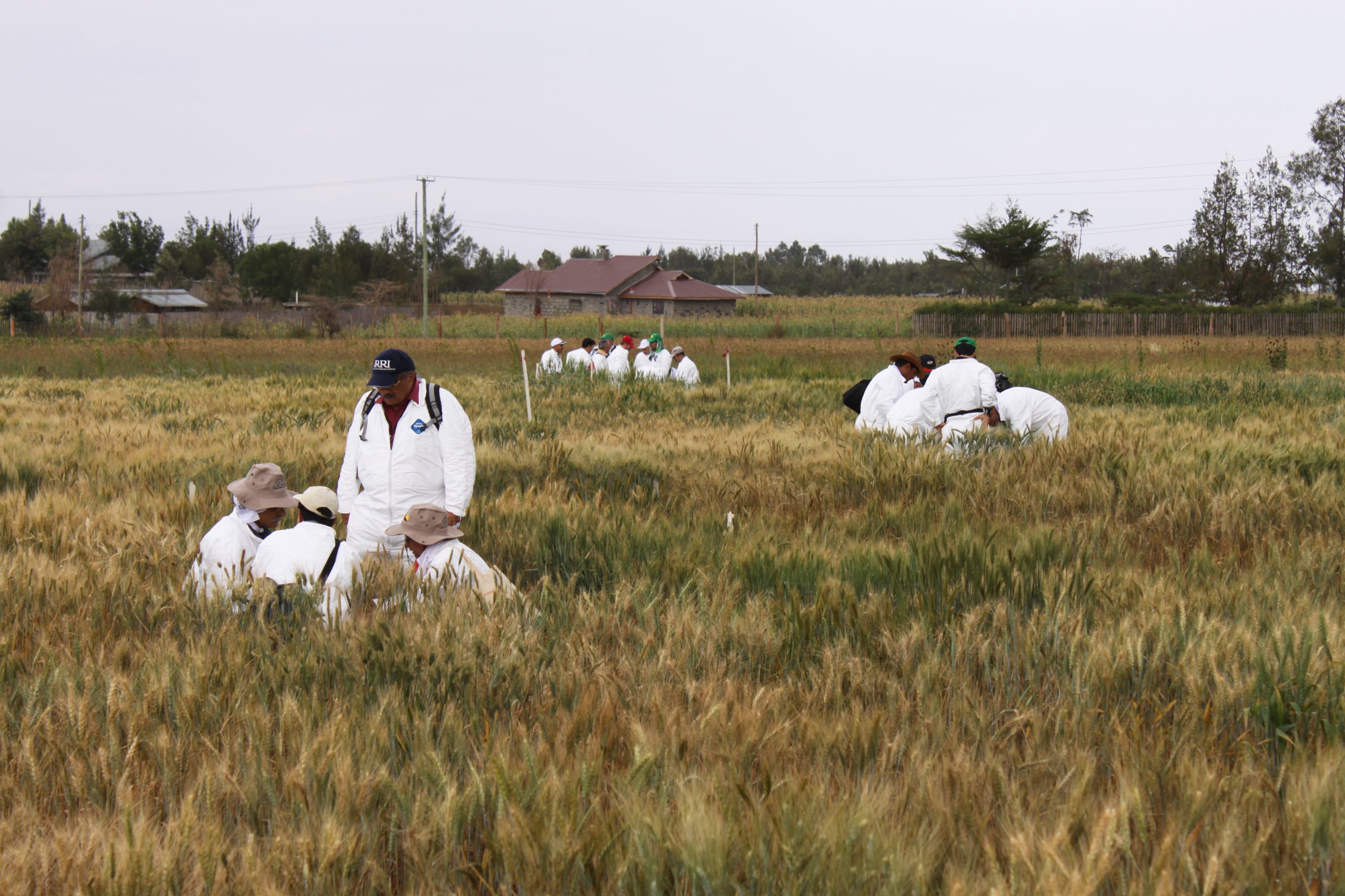
With rising demand for food, it is more critical than ever to address the challenge of crop losses due to pests and diseases. Current limited understanding of the extent of the problem prevents the advancement and implementation of plant health solutions. Global scientific collaboration is integral to ensure policy recommendations are well-informed by robust evidence and therefore more likely to succeed in the long-term.
The issue of global burden of crop loss closely correlates with the objectives of the One CGIAR Plant Health Initiative, which aims to prevent and manage major pest and disease outbreaks through the development and deployment of inclusive innovations and by building effective national, regional, and global networks. The Initiative, which is being led by the International Maize and Wheat Improvement Center (CIMMYT), will support low- and middle-income countries in Africa, Asia, and Latin America to reduce crop losses due to pests and diseases, and improve food security and livelihoods for smallholder farmers.
Data-driven approaches
The Global Burden of Crop Loss project, which is run by the Centre for Agriculture and Bioscience International (CABI), is working to ensure that there is accurate data on the challenges posed by plant pests and diseases. Questions to understand include where crop losses are the highest, the causes behind these losses, and how best these they can be addressed.
Cambria Finegold, Global Director, Digital Development, CABI said, “If you are not measuring crop loss well, then you don’t know if the extraordinary $25.8 billion spent annually on agricultural research and development is working, or if we are spending it in the right ways.”
Research by the Plant Health Initiative will play a significant role in collecting and disseminating data on some major pests and diseases, which can guide scientists on which areas to prioritize, thereby contributing to an impactful research agenda.
Once data is gathered, CABI aims to inform decision-making for actors at the top levels of the plant health system and ensure that appropriate action is taken to safeguard global food security with the limited resources available.

Establishing global networks
The value of a data-driven approach was emphasized at a session organized by the Global Burden of Crop Loss on October 14 exploring evidence-based systems to tackle food security. This session was a side event of the UN Food and Agriculture Organization (FAO) Science and Innovation Forum, which this year focused on highlighting the centrality of science, technology and innovations for agrifood systems transformation.
Prasanna Boddupalli, One CGIAR Plant Health Initiative Lead and Director of CIMMYT’s Global Maize Program, explained how the Initiative will bridge knowledge gaps, build risk assessment and rapid response capability, improve integrated pest and disease management, design and deploy tools to prevent contamination of food chains, and promote gender-equitable and socially inclusive innovations for plant health.
With six devastating plant epidemics in Africa alone during the last decade and an increased number of climate change-induced droughts and floods, Boddupalli proposed a revitalized strategy using the objectives of the Plant Health Initiative.
Built on a foundation of partnerships, there are more than 80 national, regional, and international organizations involved in the Initiative across 40 countries in the Global South, in addition to the CGIAR research centers. Through this rapidly expanding collaboration, the focus will be on establishing regional diagnostic and surveillance networks and implementing Integrated Pest Management (IPM) and integrated mycotoxin management.
To address the need for evidence-based policy recommendations, Boddupalli explained the purpose of the Plant Health Innovation Platforms in Africa, Asia and Latin America, leveraging the partners’ research sites. Combining innovations from the CGIAR system, national partners and the private sector, these platforms will enable the co-creation and validation of pest and disease management packages, with the aim of significantly improving adoption of effective and affordable plant health innovations by smallholder farmers.
Removing the barriers for data sharing
The Plant Health Initiative team has recently collected and collated information from national partners and the private sector on actions needed to remove constraints on sharing pest and disease surveillance data. Potential solutions include improved training of national partners, joint research projects, pre-defined processes for data sharing, and focusing on work that meets national and regional priorities.
These approaches will inform the sharing of data collected through the Initiative. For example, researchers are gathering surveillance data on 15 crop pests affecting seven different plants in 25 countries, with the expectation of collecting more than 44,000 samples from 2,100 sites in 2022 alone, with plans for sharing the results with partner institutions.
Boddupalli also emphasized the importance of ramping up remote sensing and drone usage, wherever feasible, for diagnostics and surveillance. However, the current gaps in accessing data and computing facilities in the Global South need to be addressed to make this a reality.
“The OneCGIAR Plant Health Initiative and the Global Burden of Crop Loss project have excellent complementarity,” said Boddupalli. Both have an opportunity to generate and share robust data on crop loss due to existing and emerging crop pests and diseases and use this data to drive effective policy change on plant health management.”
About the Global Burden of Crop Loss:
The Global Burden of Crop Loss initiative is modelled after the Global Burden of Disease initiative in human health, which has transformed health policy and research, over the last 25 years through better use of data.
The initiative aims to have a similar impact in agriculture, providing evidence to enable the global plant health community to generate actionable information and lead to a dramatic reduction in crop loss, resulting in increased food security and trade.
About the Centre for Agriculture and Bioscience International (CABI):
CABI is an international, inter-governmental, not-for-profit organization that improves people’s lives worldwide by providing information and applying scientific expertise to solve problems in agriculture and the environment.
Their approach involves putting information, skills and tools into people’s hands. CABI’s 49 Member Countries guide and influence their work which is delivered by scientific staff based in their global network of centers.
Combatting soil-borne pathogens and nematodes vital for food security

The International Maize and Wheat Improvement Center (CIMMYT) coordinated the VIII International Cereal Nematode Symposium between September 26-29, in collaboration with the Turkish Ministry of Agriculture and Forestry, the General Directorate of Agricultural Research and Policies and Bolu Abant Izzet Baysal University.
As many as 828 million people struggle with hunger due to food shortages worldwide, while 345 million are facing acute food insecurity – a crisis underpinning discussions at this symposium in Turkey focused on controlling nematodes and soil-borne pathogens causing reduced wheat yields in semi-arid regions.
A major staple, healthy wheat crops are vital for food security because the grain provides about a fifth of calories and proteins in the human diet worldwide.
Seeking resources to feed a rapidly increasing world population is a key part of tackling global hunger, said Mustafa Alisarli, the rector of Turkey’s Bolu Abant Izzet Baysal University in his address to the 150 delegates attending the VIII International Cereal Nematode Symposium in the country’s province of Bolu.
Suat Kaymak, Head of the Plant Protection Department, on behalf of the director general of the General Directorate of Agricultural Research and Policies (GDAR), delivered an opening speech, emphasizing the urgent need to support the CIMMYT Soil-borne Pathogens (SBP) research. He stated that the SBP plays a crucial role in reducing the negative impact of nematodes and pathogens on wheat yield and ultimately improves food security. Therefore, the GDAR is supporting the SBP program by building a central soil-borne pathogens headquarters and a genebank in Ankara.
Discussions during the five-day conference were focused on strategies to improve resilience to the Cereal Cyst Nematodes (Heterodera spp.) and Root Lesion Nematodes (Pratylenchus spp.), which cause root-health degradation, and reduce moisture uptake needed for proper development of wheat.
Richard Smiley, a professor emeritus at Oregon State University, summarized his research on nematode diseases. He has studied nematodes and pathogenic fungi that invade wheat and barley roots in the Pacific Northwest of the United States for 40 years. “The grain yield gap – actual versus potential yield – in semiarid rainfed agriculture cannot be significantly reduced until water and nutrient uptake constraints caused by nematodes and Fusarium crown rot are overcome,” he said.
Experts also assessed patterns of global distribution, exchanging ideas on ways to boost international collaboration on research to curtail economic losses related to nematode and pathogen infestations.
A special session on soil-borne plant pathogenic fungi drew attention to the broad spectrum of diseases causing root rot, stem rot, crown rot and vascular wilts of wheat.
Soil-borne fungal and nematode parasites co-exist in the same ecological niche in cereal-crop field ecosystems, simultaneously attacking root systems and plant crowns thereby reducing the uptake of nutrients, especially under conditions of soil moisture stress.
Limited genetic and chemical control options exist to curtail the damage and spread of these soil-borne problems which is a challenge exacerbated by both synergistic and antagonistic interactions between nematodes and fungi.
Nematodes, by direct alteration of plant cells and consequent biochemical changes, can predispose wheat to invasion by soil borne pathogens. Some root rotting fungi can increase damage due to nematode parasites.
Integrated managementFor a holistic approach to addressing the challenge, the entire biotic community in the soil must be considered, said Hans Braun, former director of the Global Wheat Program at CIMMYT.
Braun presented efficient cereal breeding as a method for better soil-borne pathogen management. His insights highlighted the complexity of root-health problems across the region, throughout Central Asia, West Asia and North Africa (CWANA).
Richard A. Sikora, Professor emeritus and former Chairman of the Institute of Plant Protection at the University of Bonn, stated that the broad spectrum of nematode and pathogen species causing root-health problems in CWANA requires site-specific approaches for effective crop health management. Sikora added that no single technology will solve the complex root-health problems affecting wheat in the semi-arid regions. To solve all nematode and pathogen problems, all components of integrated management will be needed to improve wheat yields in the climate stressed semi-arid regions of CWANA.
Building on this theme, Timothy Paulitz, research plant pathologist at the United States Department of Agriculture Agricultural Research Service (USDA-ARS), presented on the relationship between soil biodiversity and wheat health and attempts to identify the bacterial and fungal drivers of wheat yield loss. Paulitz, who has researched soil-borne pathogens of wheat for more than 20 years stated that, “We need to understand how the complex soil biotic ecosystem impacts pathogens, nutrient uptake and efficiency and tolerance to abiotic stresses.”
Julie Nicol, former soil-borne pathologist at CIMMYT, who now coordinates the Germplasm Exchange (CAIGE) project between CIMMYT and the International Center for Agricultural Research in the Dry Areas (ICARDA) at the University of Sydney’s Plant Breeding Institute, pointed out the power of collaboration and interdisciplinary expertise in both breeding and plant pathology. The CAIGE project clearly demonstrates how valuable sources of multiple soil-borne pathogen resistance in high-yielding adapted wheat backgrounds have been identified by the CIMMYT Turkey program, she said. Validated by Australian pathologists, related information is stored in a database and is available for use by Australian and international breeding communities.
Economic losses
Root-rotting fungi and cereal nematodes are particularly problematic in rainfed systems where post-anthesis drought stress is common. Other disruptive diseases in the same family include dryland crown and the foot rot complex, which are caused mainly by the pathogens Fusarium culmorum and F. pseudograminearum.
The root lesion nematode Pratylenchus thornei can cause yield losses in wheat from 38 to 85 percent in Australia and from 12 to 37 percent in Mexico. In southern Australia, grain losses caused by Pratylenchus neglectus ranged from 16 to 23 percent and from 56 to 74 percent in some areas.
The cereal cyst nematodes (Heterodera spp.) with serious economic consequences for wheat include Heterodera avenae, H. filipjevi and H. latipons. Yield losses due to H. avenae range from 15 to 20 percent in Pakistan, 40 to 92 percent in Saudi Arabia, and 23 to 50 percent in Australia.
In Turkey, Heterodera filipjevi has caused up to 50 percent crop losses in the Central Anatolia Plateau and Heterodera avenae has caused up to 24 percent crop losses in the Eastern Mediterranean.
The genus Fusarium which includes more than a hundred species, is a globally recognized plant pathogenic fungal complex that causes significant damage to wheat on a global scale.
In wheat, Fusarium spp. cause crown-, foot-, and root- rot as well as head blight. Yield losses from Fusarium crown-rot have been as high as 35 percent in the Pacific Northwest of America and 25 to 58 percent in Australia, adding up losses annually of $13 million and $400 million respectively, due to reduced grain yield and quality. The true extent of damage in CWANA needs to be determined.
Abdelfattah Dababat, CIMMYT’s Turkey representative and leader of the soil-borne pathogens research team said, “There are examples internationally, where plant pathologists, plant breeders and agronomists have worked collaboratively and successfully developed control strategies to limit the impact of soil borne pathogens on wheat.” He mentioned the example of the development and widespread deployment of cereal cyst nematode resistant cereals in Australia that has led to innovative approaches and long-term control of this devastating pathogen.
Dababat, who coordinated the symposium for CIMMYT, explained that, “Through this symposium, scientists had the opportunity to present their research results and to develop collaborations to facilitate the development of on-farm strategies for control of these intractable soil borne pathogens in their countries.”
Paulitz stated further that soil-borne diseases have world-wide impacts even in higher input wheat systems of the United States. “The germplasm provided by CIMMYT and other international collaborators is critical for breeding programs in the Pacific Northwest, as these diseases cannot be managed by chemical or cultural techniques,” he added.

Road ahead
Delegates gained a greater understanding of the scale of distribution of cereal cyst nematodes and soil borne pathogens in wheat production systems throughout West Asia, North Africa, parts of Central Asia, Northern India, and China.
After more than 20 years of study, researchers have recognized the benefits of planting wheat varieties that are more resistant. This means placing major emphasis on host resistance through validation and integration of resistant sources using traditional and molecular methods by incorporating them into wheat germplasm for global wheat production systems, particularly those dependent on rainfed or supplementary irrigation systems.
Sikora stated that more has to be done to improve Integrated Pest Management (IPM), taking into consideration all tools wherever resistant is not available. Crop rotations for example have shown some promise in helping to mitigate the spread and impact of these diseases.
“In order to develop new disease-resistant products featuring resilience to changing environmental stress factors and higher nutritional values, modern biotechnology interventions have also been explored,” Alisarli said.
Brigitte Slaats and Matthias Gaberthueel, who represent Swiss agrichemicals and seeds group Syngenta, introduced TYMIRIUM® technology, a new solution for nematode and crown rot management in cereals. “Syngenta is committed to developing novel seed-applied solutions to effectively control early soil borne diseases and pests,” Slaats said.
It was widely recognized at the event that providing training for scientists from the Global North and South is critical. Turkey, Austria, China, Morocco, and India have all hosted workshops, which were effective in identifying the global status of the problem of cereal nematodes and forming networks and partnerships to continue working on these challenges.
CGIAR Initiative: Excellence in Agronomy
Smallholdings represent over 80% of the world’s farms, mostly located in the Global South, and supply 50% of global food. Enhanced agronomy management has a great potential to increase productivity, sustainability, efficiency and competitiveness of these smallholdings, which is characterized by low and variable yields and profitability, smallholder farming challenges include water scarcity, climate change, low resource use efficiencies and declining soil health. These result in negative impacts on food and nutrition security, equitable livelihoods and ecosystem health.
Smallholder farmers seasonally make critical agronomic decisions regarding crop choice, planting dates and pest, disease, weed, soil fertility and water management, often based on suboptimal practices and information. Traditional agronomic research enhances our understanding of basic processes, but with limited connection to stakeholder demand and often based on outdated approaches. The development, deployment and uptake of interventions is hampered by social, economic and institutional constraints, further confounded by adherence to conventional supply-driven innovation strategies.
Objective
This Initiative aims to deliver an increase in productivity and quality per unit of input (agronomic gain) for millions of smallholder farming households in prioritized farming systems by 2030, with an emphasis on women and young farmers, showing a measurable impact on food and nutrition security, income, resource use, soil health, climate resilience and climate change mitigation.
Activities
This objective will be achieved through:
- Facilitating the delivery of agronomy-at-scale solutions, including development and technical/user-experience validation and the co-creation and deployment of gender- and youth-responsive solutions to smallholder farmers via scaling partners.
- Enabling the creation of value from big data and advanced analytics through the assembly and governance of data and tools; application of existing analytics and solutions for specific use cases; supply of information on climate impacts, inclusivity and sustainability of agronomic solutions; and national agricultural research system capacity strengthening.
- Driving the next generation of agronomy-at-scale innovations by addressing key knowledge gaps and facilitating innovation in agronomy research through engagement with partners.
- Nurturing internal efficiencies for an agile and demand-driven agronomy research and development community through internal organization and external partnerships for prioritization, demand mapping and foresight.
In Ethiopia, local challenges inform national action for climate-smart agriculture
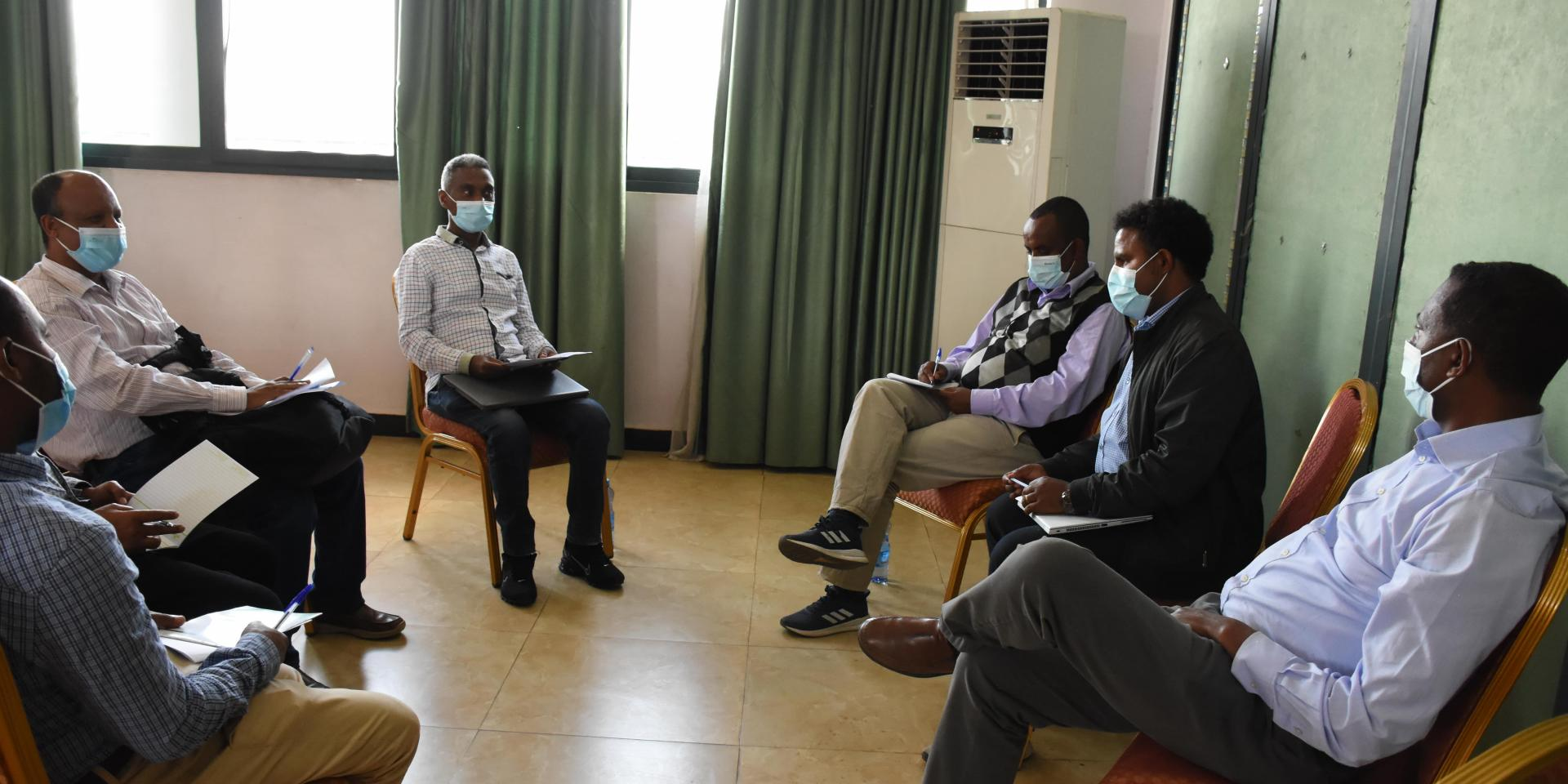
In some of Ethiopia’s most vulnerable communities, climate change is having a disastrous effect on agriculture, a critical sector to the livelihood of millions. Droughts, floods, pests, and disease outbreaks are key challenges farmers face in the age of the climate crisis. These climate-related threats have already contributed to reducing agricultural productivity and food insecurity.
In order to minimize agricultural risks from the above challenges and maximize farmers’ resilience, there is a critical need to introduce the technologies, innovations, and practices that underpin ‘climate-smart agriculture. For instance, cascading knowledge on agricultural risk management and promoting conservation agriculture may prove to be sustainable practices that address the limiting factors of food security. This, however, cannot be done in a ‘one-size-fits-all’ approach. In Ethiopia, we’ve seen how climate-smart agriculture (CSA) not only needs to be localized – so it is effective in different environments – it also needs to be inclusive, meeting the needs of women and youth in various communities.
CSA is critical to making Ethiopian farmers and their communities more resilient in the face of climate change. Awareness-raising campaigns and consultations fit an important role in engaging scientists, practitioners, and beneficiaries to understand and implement area-specific climate adaptation mechanisms through CSA-based input. A current challenge is that climate-smart interventions in Ethiopia are limited because of a lack of awareness of the necessary skill set to implement and manage those technologies properly. After all, it is wise to remember that CSA is a knowledge-intensive exercise. For instance, let us look at the Ethiopian highlands, which constitute a substantial amount of the country’s farming population. In the extreme highlands of Ethiopia – generally dubbed as Wurch or mountain zone above 3800m elevation above sea level – CSA implementation is even scarce due to climatic and socio-economic conditions. In fact, those parts of the highlands are often referred to as the “forgotten agroecology” and agricultural research institutions – both in Ethiopia and beyond – must develop and package climate-smart interventions tailored for regions that have these agroecological characteristics.
Despite some practical challenges, it is also wise to note that there are successful cases of CSA implementation and addition across the various parts of the country. This is recognized for the literature review to document CSA experiences in the country and develop a detailed ‘CSA compendium’. These experiences can promote public engagement informed and inspired by the practical experience of climate-smart interventions, both from sites that have similar agroecological characteristics – as well as different – so that farmers and communities can learn from the successes and failures of other ventures. This public engagement should be underpinned by business and financing models that work for resource-poor farmers, so they can access or invest in making their agriculture more climate-smart.
Knowing what works where will be essential to develop strategies that can facilitate targeting and scaling CSA approaches. Developing a CSA compendium, a collection of concise but detailed information on CSA practices can be an entry point to achieve this – which also requires efforts from various experts and collaboration among institutions in the country and beyond.
In line with this understanding, a recent workshop in Ethiopia brought together researchers from the Ethiopia Institute of Agricultural Research (EIAR) and the Ministry of Agriculture, the Regional Bureau of Agriculture, alongside partners from regional agricultural research institutes, Universities, and CGIAR centers.
It aimed to raise awareness among partners on the kinds of climate-smart packages of agricultural technologies and practices that are socially inclusive and responsive to the needs of young people while also being feasible from a socio-economic standpoint and ready to be expanded and delivered on a bigger scale. Key presentations were made about what CSA is and what it is not. In addition, the type and description of indicators used to identify CSA practices that are economically feasible, socially acceptable, and gender-responsive were discussed in-depth. As part of this exercise, experts identified more than 20 potential climate-smart agriculture interventions tested, validated, and implemented effectively in different parts of the country.
Some of the key presentations and discussions at the workshop revealed critical lessons for implementing CSA:
- Climate-smart agriculture is not a set of practices that can be universally applied but rather an approach that involves different elements embedded in local contexts.
- Climate-smart agriculture relates to actions both on farms and beyond the farm, incorporating technologies, policies, institutions, and investment.”
- Climate-smart agriculture is also a continuous process, though we should focus on the big picture and avoid trivial debates about whether CSA is a practice, technology, or an option.
- Due consideration should be given to gender sensitiveness and social inclusiveness as a criterion in identifying compelling innovations.
- Better indicators should be developed in measuring how climate-smart agriculture is adopted.
The workshop was the first of a series planned to raise awareness of different approaches to climate-smart agriculture while aligning Ethiopian institutions behind common understandings of how climate-smart agriculture can be delivered at both a local and national level.
In closing this first workshop, Ermias Abate, Deputy Director-General of the Amhara Region Agricultural Research Institute, stated, “Agriculture wouldn’t move an inch forward if we continued with business as usual and hence the need to be smart to face the new realities of agriculture under climate change.”
The Accelerating Impacts of CGIAR Climate Research in Africa (AICCRA) workshop was held between December 24 and 25, 2021, in Bahir Dar, Ethiopia, and was organized jointly by:
- The Alliance of Bioversity International and the International Center for Tropical Agriculture (CIAT)
- CGIAR Program on Climate Change Agriculture and Food Security (CCAFS)
- International Maize and Wheat Improvement Center (CIMMYT)
- International Center for Agricultural Research in the Dry Areas (ICARDA) and
- International Livestock Research Institute (ILRI)
Scientists step up wheat landrace conservation efforts in Afghanistan, Turkey and other countries in the region
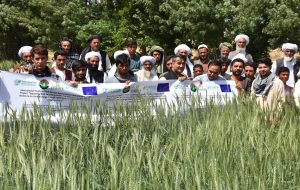
For thousands of years, farmers in Afghanistan, Turkey and other countries in the region, have been breeding wheat, working closely with the environment to develop traditional wheat varieties known as landraces. Untouched by scientific breeding, landraces were uniquely adapted to their environment and highly nutritious.
As agriculture became more modernised and intensified, it threatened to push these traditional landraces into extinction, resulting in the loss of valuable genetic diversity. Institutions around the world decided to act, forming germplasm collections known as genebanks to safely house these landraces.
In 2009, a team of wheat scientists from the International Maize and Wheat Improvement Center (CIMMYT), the International Center for Agricultural Research in the Dry Areas (ICARDA), the UN Food and Agriculture Organization (FAO), and national partners set off on a five-year expedition across Central Asia to collect as many landraces as they could find. The project, led by FAO Cereal Breeder and former CIMMYT Principal Scientist Alexey Morgunov, was made possible by the International Treaty on Plant Genetic Resources for Food and Agriculture Benefit-Sharing Fund.
The project had two main missions. The first is to preserve landrace cultivation in three countries, Afghanistan, Turkey and other countries in the region by selecting, purifying, and multiplying the landraces and giving them back to farmers. The second is to scientifically evaluate, characterize and use these landrace varieties in ongoing breeding programmes, exchange the information between the countries, and to deposit the seeds in genebanks to safely preserve them for future generations.
The latest results from the project were published in July in the journal Crops. The study, authored by a team of experts from CIMMYT, ICARDA, FAO, and research institutes in Afghanistan, Turkey and other countries in the region, compared the diversity, performance, and adaptation of the collected wheat landraces with modern varieties grown in the regions using a series of field experiments and cutting-edge genomic tools.
“Landraces are very useful from a breeding perspective because they have been cultivated by farmers over thousands of years and are well adapted to climate change, have strong resistance to abiotic stresses and have very good nutritional quality,” said Rajiv Sharma, a CIMMYT senior scientist and co-author of the paper.
“We were interested in seeing how well landraces adapt to certain environments, how they perform agronomically, and whether they are more diverse than modern varieties grown in these regions – as well as give their improved versions back to farmers before they are lost.”
The experiments, which were carried out in 2018 and 2019 in Turkey, and 2019 in Afghanistan, and other countries in the region revealed several physical characteristics in landraces which are no longer present in modern varieties. For example, the team found striking differences in spike and grain colors with landraces more likely to have red spikes and white grains, and modern varieties tending to have white spikes and red grains. This may have adaptive values for high altitudes and dry conditions.
A surprising finding from the study, however, was that landraces were not more genetically diverse than modern landraces.
“Many people thought that when we went from cultivating landraces to modern varieties, we lost a lot of diversity but genetically speaking, that’s not true. When you look at the genomic profile, modern varieties are just as diverse as landraces, maybe even a little bit more so,” said Sharma.
When the team compared landraces and modern varieties on crop performance, the results were mixed with modern wheat varieties outyielding landraces in half of the environments tested. However, they found that the highest yielding landraces were just as good as the best modern varieties – a reassuring finding for farmers concerned about the productivity of their crops.
A new breeding paradigm
The results of the study have important implications for landrace conservation efforts in farmers’ fields and in future breeding strategies. While crossing wheat landraces with modern varieties to develop improved modern varieties is not new, the authors proposed a novel alternative breeding strategy to encourage the continued cultivation of landraces: improving landraces by crossing them with other landraces.
“In order to maintain landraces, we have to make them competitive and satisfy farmers’ needs and requirements. One option is that we breed landraces,” said Sharma.
“For example, you might have a landrace that is very-high yielding but susceptible to disease. By crossing this variety with another landrace with disease-resistant traits you can develop a new landrace better suited to the farmer and the environment. This approach maintains all the features of landraces – we are simply accelerating the evolution process for farmers to replace the very fast disappearance of these traditional varieties.”
This approach has already been used by crop scientists at the University of California, Davis who has successfully developed and registered “heirloom-like varieties” of dry beans. The varieties trace about 98% of their ancestry to landraces but are resistant to the common mosaic virus.
Heirloom food products are becoming increasingly popular with health-conscious consumers who are willing to pay a higher price for the products, garnering even more interest in conserving traditional landraces.
One of the overarching aims of the project was to give wheat landraces back to farmers and let nature take its course. Throughout the mission, the team multiplied and returned landrace seed to over 1500 farmers in communities across Afghanistan, Turkey and other countries in the region. The team also supplied over 500 farmers with improved landrace seed between 2018 and 2019.
Despite the political turmoil facing these countries, particularly Afghanistan, farmers are still growing wheat and the project’s contribution to food security will continue.
These landraces will take their place once more in the farming landscape, ensuring on-farm wheat diversity and food security for future generations.
This research was conducted with the financial assistance of the European Union within the framework of the Benefit-Sharing Fund project “W2B-PR-41-TURKEY” of the FAO’s International Treaty on Plant Genetic Resources for Food and Agriculture.
CGIAR Plant Health Initiative formally launched on the International Day of Plant Health

CGIAR together with national, regional, and international partners kicked off the Plant Health and Rapid Response to Protect Food Security and Livelihoods Initiative also known as the Plant Health Initiative in Nairobi, Kenya, on May 12-13, 2022. The Initiative’s inception meeting was fittingly held on the first-ever International Day of Plant Health on May 12 and was attended by over 200 participants (both in-person and virtual), representing diverse institutions.
The Plant Health Initiative targets a broad range of pests and diseases affecting cereals (especially rice, wheat and maize) and legumes such as beans, faba bean, chickpea, lentil, and groundnut; potato; sweet potato; cassava; banana; and other vegetables.
Speaking at the meeting, CGIAR Plant Health Initiative Lead and Director of Global Maize Program at the International Maize and Wheat Improvement Center (CIMMYT) noted that climate change, together with human activities and market globalization, is aggravating challenges to plant health, including outbreaks of devastating insect-pests and diseases. In addition, according to data from the African Union Partnership on Aflatoxin Control in Africa (AUC-PACA), 40 percent of commodities in local African markets exceed allowable levels of mycotoxins in food, causing adverse effects on diverse sectors, including agriculture, human health, and international trade.
“The CGIAR Plant Health Initiative is, therefore, a timely program for strengthening inter-institutional linkages for effective plant health management especially in the low- and middle-income countries in Africa, Asia, and Latin America, said Prasanna. “This calls for synergizing multi-stakeholder efforts to improve diagnostics, monitoring and surveillance, prediction and risk assessment of transboundary pests and pathogens, and implementing integrated pest and disease management in a gender-responsive and socially inclusive manner.”
Demand-driven multistakeholder approach
CGIAR Global Science Director for Resilient Agrifood Systems Martin Kropff reiterated the importance of the Initiative, and emphasized the need for a global plant health research-for-development consortium. He mentioned that all the CGIAR Initiatives, including the Plant Health Initiative, are demand-driven and will work closely with national, regional, and international partners for co-developing and deploying innovative solutions.
The chief guest at the event, Oscar Magenya, Secretary of Research and Innovation at Kenya’s Ministry of Agriculture, pointed out the need for a well-coordinated, multisectoral and multistakeholder approach to managing invasive pests and diseases. He recognized CGIAR’s contribution and partnership with the Government of Kenya through CIMMYT, especially in combating maize lethal necrosis and wheat rust in Kenya.
“As government, we invite the CGIAR Plant Health Initiative to partner with us in implementing the Migratory and Invasive Pests and Weeds Management Strategy that was launched recently [by the Kenya Government],” said Magenya.
Implications of Plant Health in Africa and globally
Zachary Kinuya, Director of Crop Health Program at the Kenya Agricultural and Livestock Research Organisation (KALRO) spoke on the importance of plant health management to African stakeholders, and observed that in addition to improved crop production, food and feed safety must be given adequate priority in Africa.
Director of the Plant Production and Protection Division at the UN Food and Agriculture Organization (FAO), Jingyuan Xia applauded CGIAR for launching the global Initiative. Through his virtual message, Xia stated that the goals of the two organizations are aligned towards supporting farmers and policy makers in making informed decisions and ultimately ending global hunger. He added that the CGIAR has strong research capacity in developing and disseminating new technologies.
CIMMYT Director General Bram Govaerts explained how negative impacts on plant health, combined with climate change effects, can lead to global production losses and food system shocks, including the potential to result in food riots and humanitarian crises. He challenged stakeholders in the meeting to resolve tomorrow’s problems today, through collective and decisive action at all levels.

The German development agency (GIZ) Fund International Agricultural Research (FIA) Advisor Sarah Schmidt said that GIZ supports the Initiative because of its interest in transformative approaches in innovations for sustainable pest and disease management. Recognizing women’s major involvement in farming in Africa, Schmidt said there is a need to empower and equip women with knowledge on plant health as this will result to greater productivity on farms in Africa. “We welcome that the Plant Health Initiative dedicated an entire crosscutting work package to equitable and inclusive scaling of innovations,” she added.
Participants at the launch were also reminded by Ravi Khetarpal, Executive Secretary of the Asia-Pacific Association of Agricultural Research Institutions (APAARI), that the Initiative is now at the critical phase of Implementation and requires diverse actors to tackle different issues in different geographies. Ravi added that biosecurity and plant health are important subjects for the Asia-Pacific region, in view of the emergence of new pests and diseases, and therefore the need to save the region from destructive pest incursions.
Other online speakers at the launch included Harold Roy Macauley, Director General of AfricaRice & CGIAR Regional Director, Eastern and Southern Africa; Nteranya Sanginga, Director General of the International Institute of Tropical Agriculture (IITA) and CGIAR Regional Director, West and Central Africa; and Joaquin Lozano, CGIAR Regional Director, Latin America & the Caribbean.
Reflecting on gender, social inclusion, and plant health
Panel discussions allowed for more in-depth discussion and recommendations for the Initiative to take forward. The panelists delved into the progress and challenges of managing plant health in the Global South, recommending a shift from a reactive to a more proactive approach, with strong public-private partnerships for sustainable outcomes and impacts.
Gender inequities in accessing the plant health innovations were also discussed. The discussion highlighted the need for participatory engagement of women and youth in developing, validating and deploying plant health innovations, a shift in attitudes and policies related to gender in agriculture, and recognition and deliberate actions for gender mainstreaming and social inclusion for attaining the Sustainable Development Goals (SDGs).

Charting the course for the Initiative
The Plant Health Initiative Work Package Leads presented the Initiative’s five specific work packages and reiterated their priorities for the next three years.
“We are looking forward to taking bold action to bring all players together to make a difference in the fields of farmers all over the world,” said Prasanna.
The Initiative is poised to boost food security, especially in key locations through innovative and collaborative solutions.
For more information, visit the CGIAR Plant Health Initiative page or download a brief.
Panel Discussion Presentations
“Plant Health Management in the Global South: Key Lessons Learnt So Far, and the Way Forward” moderated by Lava Kumar (IITA) with panelists: Florence Munguti [Kenya Plant Health Inspectorate (KEPHIS)], Maryben Chiatoh Kuo (African Union-Inter-African Phytosanitary Council), Roger Day (CABI) and Mark Edge (Bayer).
“Scaling Strategy, including Gender and Social Inclusiveness of Plant Health Innovations” moderated by Nozomi Kawarazuka (CIP), with panelists Jane Kamau (IITA), Alison Watson (Grow Asia), Sarah Schmidt (GIZ), Aman Bonaventure Omondi (Alliance Bioversity-CIAT) and Nicoline de Haan (CGIAR Gender Platform)
Work Package Title and Leads
Work Package 1: Bridging Knowledge Gaps and Networks: Plant Health Threat Identification and Characterization
Lead: Monica Carvajal, Alliance of Bioversity-CIAT
Work Package 2: Risk Assessment, data management and guiding preparedness for rapid response
Lead: Lava Kumar, IITA
Work Package 3: Integrated pest and disease management
Lead: Prasanna Boddupalli, CIMMYT
Work Package 4: Tools and processes for protecting food chains from mycotoxin contamination
Lead: Alejandro Ortega-Beltran, IITA
Work Package 5: Equitable and inclusive scaling of plant health innovations to achieve impacts Co-leads:Nozomi Kawarazuka, International Potato Center (CIP), Yanyan Liu, International Food Policy Research Institute (IFPRI)
Accelerating Impacts of CGIAR Climate Research for Africa (AICCRA)
The Accelerating Impacts of CGIAR Climate Research for Africa (AICCRA) project is an initiative that will enhance access to climate information services and validated climate-smart agriculture technologies in Africa.
AICCRA aims to support farmers and livestock keepers to better anticipate climate-related events and take preventative actions, with better access to climate advisories linked to information about effective response measures.


